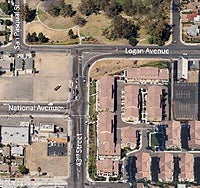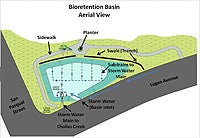43rd Street and Logan Avenue
Project Background
The City of San Diego is installing a Low Impact Development (LID) pilot project as part of roadway improvements surrounding the intersection of 43rd Street and Logan Avenue. The LID effort will use best management practices (BMPs) to help capture and treat storm water before it can enter nearby Chollas Creek.
The project includes a biofiltration basin and filtration cells designed to improve water quality. The Chollas Creek Watershed is listed on the federal government's "303(d) List of Impaired Waters" for metals and bacteria, and is subject to Total Maximum Daily Loads (TMDLs) requirements for these pollutants. Because of the restrictions, the City has modified its traditional LID design to incorporate new techniques including filtration and evapotranspiration features to reduce pollutant loads. The new BMPs will be installed to allow storm water and other urban runoff to move through a carefully designed series of filtering steps reducing both runoff volume and pollutant loads.
The City is installing these features in three areas of the site:
- Within the easterly parkway of 43rd Street;
- Within the southerly parkway of Logan Avenue; and
- In an open space parcel (the "Triangle Lot") along the north side of Logan Avenue from Dominion Street to San Pasqual Street.
The proposed BMPs have been designed to remove pollutants from tributary storm water runoff in compliance with the requirements of the City of San Diego Land Development Manual, Storm Water Standards, March 24, 2008. In addition, the performance of these BMPs will be investigated to determine compliance with the Chollas Creek TMDLs for metals and bacteria.
This proposed watershed protection project will be located at the new four-corner intersection of 43rd Street, National Avenue, San Pasqual Street and Logan Avenue. The project is intended to reduce storm water pollutants that enter Chollas Creek by processing the roadway storm water runoff through bio-filters. It meets both specific requirements within the Municipal Storm Water Permit and our program's overall goals. It does so in a way the combines the construction of these storm water futures with construction of the needed road realignment. It also includes architectural elements to make it not only functional, but also a streetscape amenity.
Component 1 - Curbside Biofiltration
This component incorporates 25 filter cells located in the landscaping strip between the curb and the sidewalk. Storm water runoff from the adjacent travel lanes will drain into special inlets that filter out trash, and then will filter through a specified soil mix that will remove metals and other roadway pollutants. The surface finish will be pavers with an open diamond shaped pattern, filled with decorative rock.
Component 2 - Bioretention Basin
This component will divert additional storm water runoff from the roadway into a shallow landscaped basin that is designed to filter the runoff through a specified soil mix for removal of metals and other roadway pollutants. This component will be built on a remnant section of City right-of-way that will no longer be needed after the road realignment is completed. This area will include an enhanced landscaping plan, to be refined with further input from the Community College District.
Benefits
This project will help protect Chollas Creek and San Diego Bay through:
- Reduction of water-borne pollutants
- Reduction in the volume of storm water
- Improved drainage near current storm drain inlets
- Enhanced aesthetics: new landscaping features
- 43rd Street and Logan Avenue Bio-filtration Pilot Project Fact Sheet (PDF)
- 43rd Street and Logan Avenue Baseline Effectiveness Assessment Monitoring Report (PDF)
- 43rd Street and Logan Avenue Bio-filtration Pilot Project Design Plans
- Design Plan #1 (PDF)
- Design Plan #2 (PDF)
- Design Plan #3 (PDF)
- Site Location (photo)
- Curbside Biofiltration Aerial View (photo)
- Curbside Biofiltration Side View (photo)
- Biofilter Basin Aerial View (photo)
- Biofilter Basin Side View (photo)
If you would like to receive more information about this project, please email us at engineering@sandiego.gov.




